MI503: Miscon Three:
The idea that CMBR came from the Big Bang is a Giant Misconception
David Noel
<davidn@aoi.com.au>
Ben Franklin Centre for Theoretical Research
PO Box 27, Subiaco, WA 6008, Australia.
What is CMBR?
CMBR stands for Cosmic Microwave Background Radiation. The radiation from space that we know most about is Light, such as we get from the Sun and from stars, and (by reflection) from the Moon and some of the closer planets. Light, or the visible band in electromagnetic radiation, falls roughly in the middle of the whole electromagnetic spectrum.
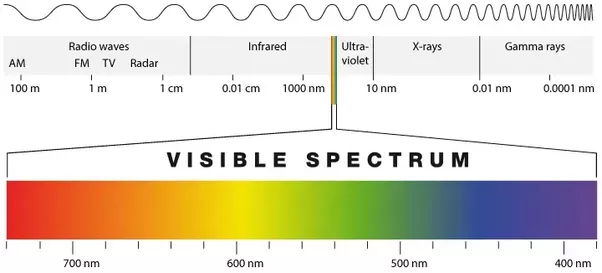
Figure MI503-F1. The electromagnetic spectrum. From [1].
The place where a given bit of radiation falls in the whole spectrum is determined by its wavelength. In the figure, shorter wavelengths are shown on the right. Shorter wavelength is the same as higher frequency, and higher energy, so the highest known energy is found in gamma rays, with wavelengths less than 0.01 nm (1 nm or nanometre is one-billionth of a metre).
The lowest-energy waves are found in some radio waves, which have wavelengths as big as 100 metres. Visible-light waves have wavelengths just under 1 micron, one millionth of a metre -- in the real world, you may see rainbow effects from things like the pits in DVD discs, or the thin film on oil slicks, because these are of similar size to light wavelengths.
CMBR has radiation of wavelengths around 1 centimetre. Although its name contains the word "microwave", CMBR actually lies at the boundary of true microwaves and far-infrared. It can be detected coming from all areas of the sky, and is actually a major part of the radiation sluicing through the whole of space. Here is an extract from what Wikipedia says about it [2].
"Cosmic microwave background radiation (CMBR), in Big Bang cosmology, is electromagnetic radiation left as a remnant from an early stage of the universe, also known as "relic radiation". It is faint cosmic background radiation filling all space. It is an important source of data on the early universe because it is the oldest electromagnetic radiation in the universe.
With a traditional optical telescope, the space between stars and galaxies (the background) is completely dark. However, a sufficiently sensitive radio telescope shows a faint background noise, or glow, almost isotropic, that is not associated with any star, galaxy, or other object. This glow is strongest in the microwave region of the radio spectrum. The accidental discovery of the CMBR in 1964 by American radio astronomers Arno Penzias and Robert Wilson was the culmination of work initiated in the 1940s, and earned the discoverers the 1978 Nobel Prize in Physics.
CMBR is landmark evidence of the Big Bang origin of the universe. When the universe was young, before the formation of stars and planets, it was denser, much hotter, and filled with a uniform glow from a white-hot fog of hydrogen plasma. As the universe expanded, both the plasma and the radiation filling it grew cooler.
The photons that existed at the time of photon decoupling have been propagating ever since, though growing fainter and less energetic, since the expansion of space causes their wavelength to increase over time (and wavelength is inversely proportional to energy). The surface of last scattering refers to the set of points in space at the right distance from us so that we are now receiving photons originally emitted from those points at the time of photon decoupling."
This article looks at the facts about CMBR in greater details, and shows the commonly-accepted view of its origin, such as that quoted above from Wikipedia, is actually a major misconception, a Miscon. First we can look at the position of CMBR as its proportion of the radiation sweeping through space -- a view seldom shown.

Figure MI503-F2. Percentage Radiation Densities in the Universe. From [3].
The data in the above figure applies to radiation falling on a detector in deep space, roughly the same as that seen at midnight on a moonless night on Earth. It shows the energy contained in such radiation. It can be seen that the biggest proportion of this energy, over 70%, is CMBR. Most of the rest is Infrared, less than 3% is visible light, and only a small part (much less than 1%) is in the higher-frequency stuff like ultraviolet and gamma rays.
So CMBR is a major player when considering the radiation flooding through space. When considered in terms of photons, CMBR is even more prominent, over 90% of space radiation is CMBR photons.
The pattern of this CMBR radiation is very stable, lies at a specific tight wavelength band, shows hardly any variation over long periods, and is almost the same over all areas of the sky. We now need to consider how well this pattern fits with a supposed origin at the Big Bang, as described in Wikipedia [1].
Did CMBR come from the Big Bang?
Simple application of commonsense shows that the model dependent on the Big Bang gives a very poor fit with what is actually observed with CMBR. Let us list some of the Big-Bang claims.
1. CMBR is left over from the Big Bang. It utterly strains logic to assume that radiation created 13.7 billion years ago could still exist as such a major component of space radiation. CMBR will clearly be absorbed on impact with matter. If only 1-billionth was absorbed per year, it would all be gone billions of years ago.
2. The wavelength of CMBR has been stretched by expansion of the Universe. The Big Bang model says that CMBR was created at visible-light wavelengths, and stretched by expansion of the Universe down to the current 1 cm band. As the latest telescopes have detected visible light from galaxies as much as 13 billion light-years away, and so of close age to the supposed Big Bang, it might be asked why this light, also, is not stretched down to the 1 cm band also.
3. CMBR dilution from expansion. If the CMBR was released into a very much smaller universe, which has been stretched by expansion, how could enough still be left to fill the modern Universe?
Where does CMBR really originate?
We'll look at the real source of CMBR shortly. At the moment, it is sufficient to assert that, reviewing the real facts, it is really only feasible for CMBR to present such a stable and universal set of conditions, if it is in continuous generation as a normal feature of the Universe.
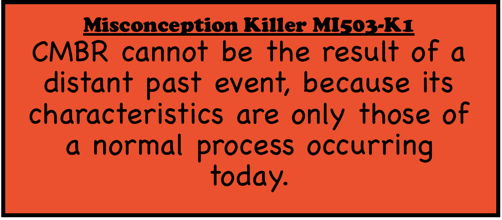
Another article in this series, Miscon One: The "Big Bang Theory" is a Giant Misconception [4], shows that the Big Bang theory is itself also only a giant misconception. So we should abandon any suggestion that CMBR comes from a past event, and look for a source in the Universe as it is today.
What does the CMBR spectrum look like?
Figure F3 below shows the spectrum observed for CMBR. It is almost exactly the same, wherever in the sky a suitable radio-telescope is pointed. There is a very obvious intensity peak at a wavelength a little above 1 mm.
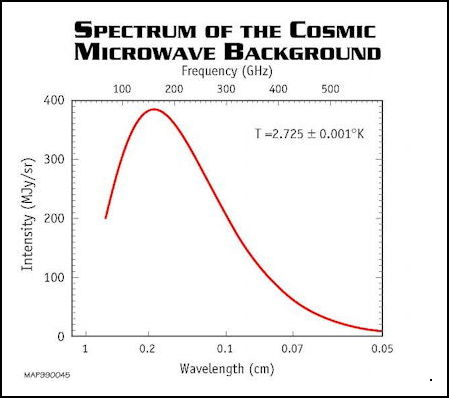
Figure MI503-F3. Spectrum of the Cosmic Microwave Background Radiation. From [6].
On the right-hand side of the figure, the intensity fall away gradually with decreasing wavelength (higher frequency and energy content), gradually approaching almost to zero. On the left-hand side, the curve also falls away, but observations cease at a wavelength of about 8 mm. The significance of this tail-end will be mentioned later.
On the top right of the graph is an equation, T=2.725 +/- 0.001 K. This a temperature associated with the peak, a temperature of 2.725 degrees above Absolute Zero. In terms of everyday Celsius degrees, it is a little more than Minus 270 C. At absolute zero, matter it so cold that it contains no heat or other energy whatsoever.
We'll now go on to explain the connection between the temperature of a body which emits radiation, and the wavelength of its emissions.
Black-body radiation
All bodies in the Universe emit radiation, and the peak wavelength of this radiation depends directly on their surface temperatures. The formula relating the two was published in 1900 by the famous German scientist Max Planck (today, most of Germany's leading scientific research centres are designated "Max Planck Institutes").
In Planck's treatment, the emitting body is called a "black body". This is shorthand for an object which completely absorbs radiation of any wavelength [6]. The formula which Planck developed is called the Planck Radiation Law. It relates the intensity of radiation emitted (by unit surface area into a fixed direction from a body) as a function of wavelength for a fixed temperature.
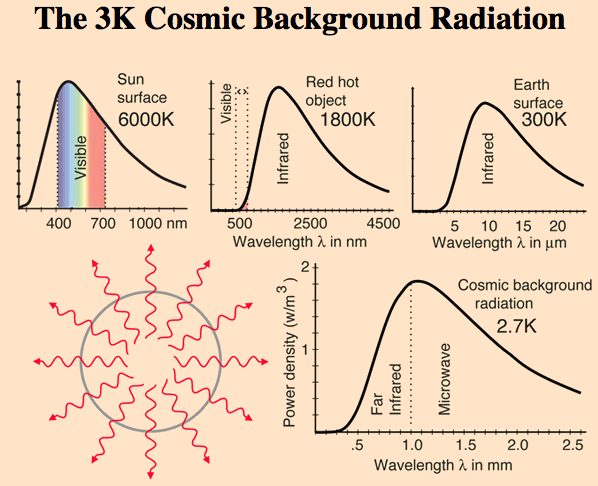
Figure MI503-F4. Black-Body radiation applies along the whole spectrum. From [6].
Figure F4 above shows the outcome of this law on things at various temperatures. The top-left curve shows the wavelengths emitted by the hot surface of a star such as our Sun. A surface like this has a temperature around 6000 K (degrees above absolute zero). About half the radiation from the Sun is as visible light. Most of the rest is infrared, which we perceive as heat, with a smaller amount of ultraviolet.
The centre-top curve is for a red-hot object, such as a heated iron bar. Only a little of its radiation is as visible light, the rest is infrared. Notice that the shapes of all the curves are similar, just displaced in wavelength -- a consequence of them obeying the Planck Radiation Law.
With objects on the Earth's surface, such as a building or a person, at 300 K (27 degrees C) their radiation is all in the infrared. The bottom-right curve shows the "black-body" radiation for very cold objects at under 3 K.
When CMBR was first detected, it was noticed immediately that it conformed closely with black-body radiation from very cool objects at around 2.7 K -- that is the origin of the T = 2.75 K equation in Figure F3.
What happened next was one of the great blunders in science. Instead of looking round for a very cool material as the source of CMBR, it was suggested that CMBR was formed at a high temperature in the Big Bang, and had become wavelength-stretched by expansion of the Universe. Although this somehow became generally accepted as the right explanation, we have shown above that it is not valid.
Apart from the reasons already given, it is notable that even Big-Bang adherents do not claim that the Big Bang had black-body conditions when it was young, and so it had no reason to give radiation with the observed curves. Moreover, the suggested expansion could not have retained the wavelength shape uniformly and universally during this expansion.
For the full story, see P2: The Oort Soup as the real origin of Cosmic Microwave Background Radiation [5].
So where does CMBR originate?
There is a very good answer to this question, one which in retrospect might be claimed to be blindingly obvious. Our Solar System is surrounded by an immense cloud of interstellar material, which we call the Oort Cloud.
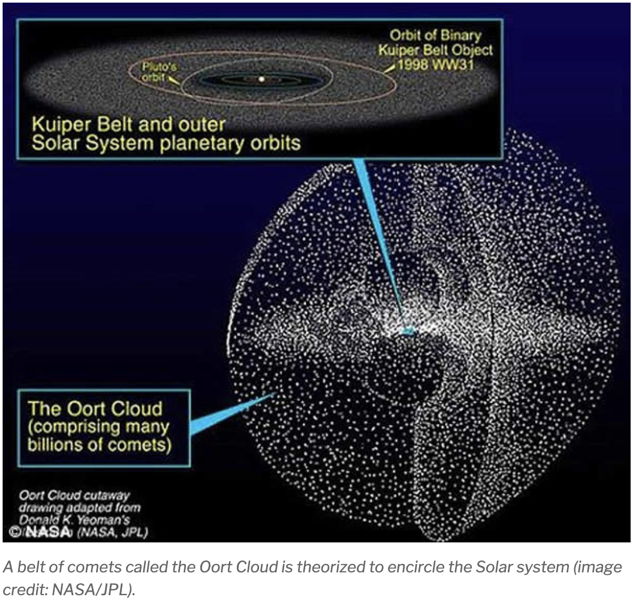
Figure MI503-F5. The Oort Cloud. From NASA.
Bodies in space near to the Sun clearly get more energy from the Sun, the closer they are to it. So Mercury and Venus are hotter than Earth, and Mars and Jupiter and the other outer planets are colder.
The outer boundary of the Solar System proper, the Heliosphere, can be reckoned to extend out to 100 AU from the Sun (1 AU, 1 astronomical unit, is the distance from Earth to the Sun). The Oort Cloud has no definite boundary as such, but for purposes of reckoning can be regarded as a sphere of radius 100,000 AU, taking it almost half-way to the nearest star, about 4 light-years distant.
Because it gets colder with distance from the Sun, bodies at the edge of the Heliosphere are at about 3 K, and get progressively colder as you move further out into the Oort Cloud. So CMBR is just the normal black-body radiation emitted from objects in the deeper Oort Cloud, with the "median" distance for objects at 2.75 K.
In a reversal of logic, the impelling validity of this picture is realized by asking, "What must be the black-body emission pattern of matter scattered in the Oort Cloud?". The only reasonable answer is a pattern just like that of CMBR.
A new start for researching CMBR
One of the big drawbacks of the misconception that CMBR came from the Big Bang was that its further scientific analysis was stymied by the use of this inaccurate model. With the realization that CMBR comes from the Oort Cloud, its study allows us to find out more about the nature and distribution of this interstellar matter, which can be dubbed "Oort Soup".
Perhaps the most unexpected discovery to emerge from these studies is that this Oort Soup is none other than the mysterious Dark Matter, for which scientist searched for many, many years. Dark Matter turns out to be just the ordinary matter in Oort Soup bodies, it is only Dark because it is too far from a star to observe by reflected light, and too cold to shine by its own light. For more on this, see MI504: Miscon Four: Dark Matter is different from ordinary matter [7].
The tale of the tail
The new physical picture of the origin of CMBR gives us a possible insight as to why the CMBR curve in Figure F3 falls away from the peak to leave a "tail" on the left-hand, lower-temperature side.
These radiation curves actually represent the superimposition of multiple curves from emitters lying along an extended range of conditions. Figure F3 is essentially made up of the black-body emissions from Oort Soup bodies, closer to the Sun and warmer, on the right-hand side, increasing with increasing amounts of material as you move further from the Sun, up to a peak with the "median" bodies at a temperature of 2.725 K, and then falling off on going further and further from the Sun, into colder and colder reaches of space.
Why does the curve fall away at all, once it has reached the peak? The answer seems to be, that if you go out far enough from the Sun, you eventually reach the furthest spheres of influence of other stars. In other words, any straight line pointing out from the Sun will eventually reach the warming influence of another star, so the CMBR curve ceases when bodies which are colder still can no longer be encountered.
There is more on this at P3: Living In The Universe: (What CMBR tells us about Dark Matter, and much more) [6].
* * * * * * * * * * * * * * * * * *

References and Links
[1]. What different uses do electromagnetic waves have?. https://www.quora.com/What-different-uses-do-electromagnetic-waves-have .
[2]. Cosmic microwave background. https://en.wikipedia.org/wiki/Cosmic_microwave_background .
[3]. David Noel. UG101: Recycling the Universe: Neutron Stars, Black Holes, and the Science of Stuff. http://www.aoi.com.au/Recycling/ .
[4]. David Noel. MI501: Miscon One: The "Big Bang Theory" is a Giant Misconception. http://www.aoi.com.au/acceptology/MI501/index.htm .
[5]. David Noel. P2: The Oort Soup as the real origin of Cosmic Microwave Background Radiation. http://www.aoi.com.au/OortSoup/index.htm .
[6]. David Noel. P3: Living In The Universe: (What CMBR tells us about Dark Matter, and much more). http://aoi.com.au/Living/ .
[7]. David Noel. MI504: Miscon Four: Dark Matter is different from ordinary matter. http://www.aoi.com.au/acceptology/MI504/index.htm .
Go to the Acceptology Home Page

Version 1.0 compilation started 2019 Aug 6, first version on Web 2019 Aug 12.









